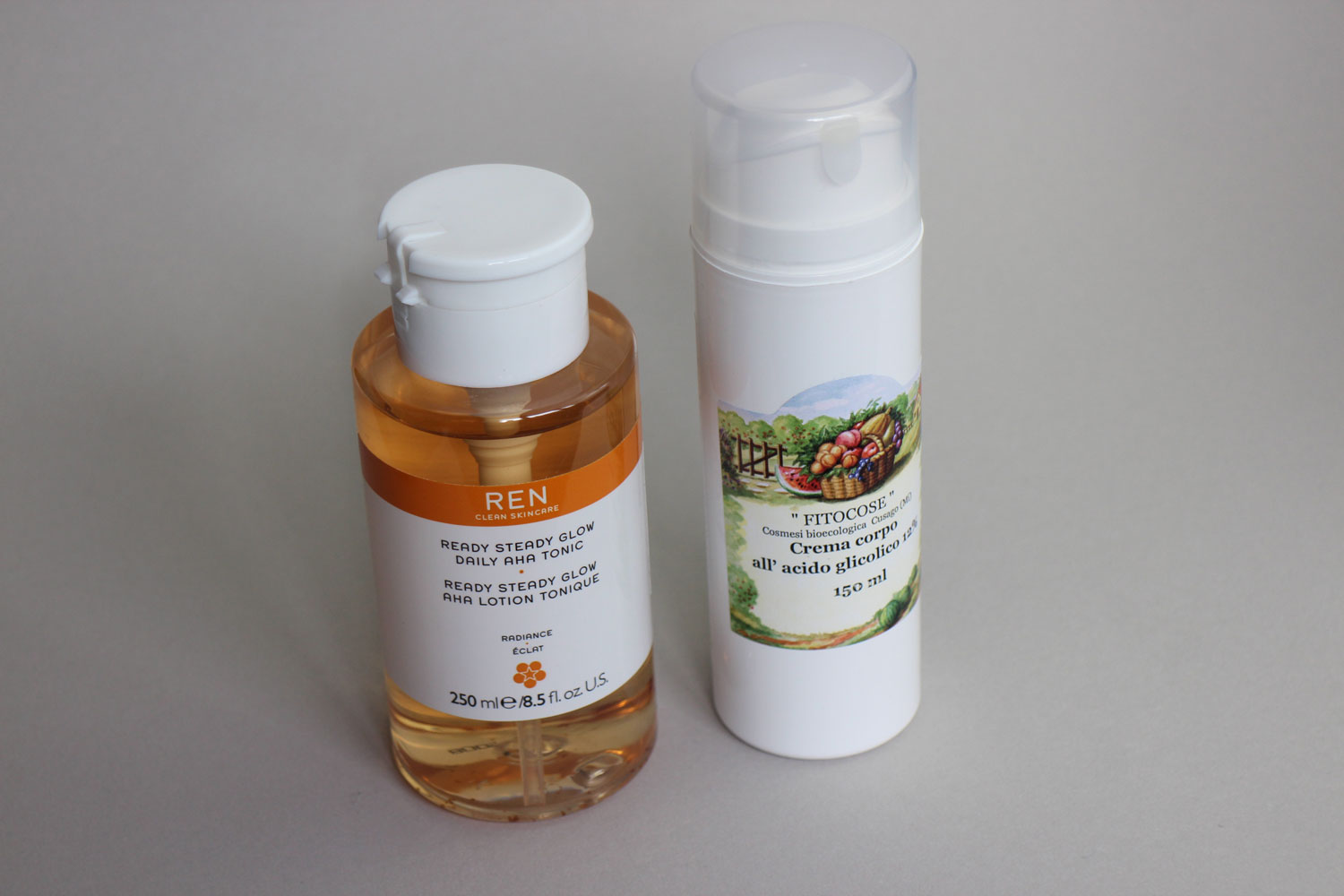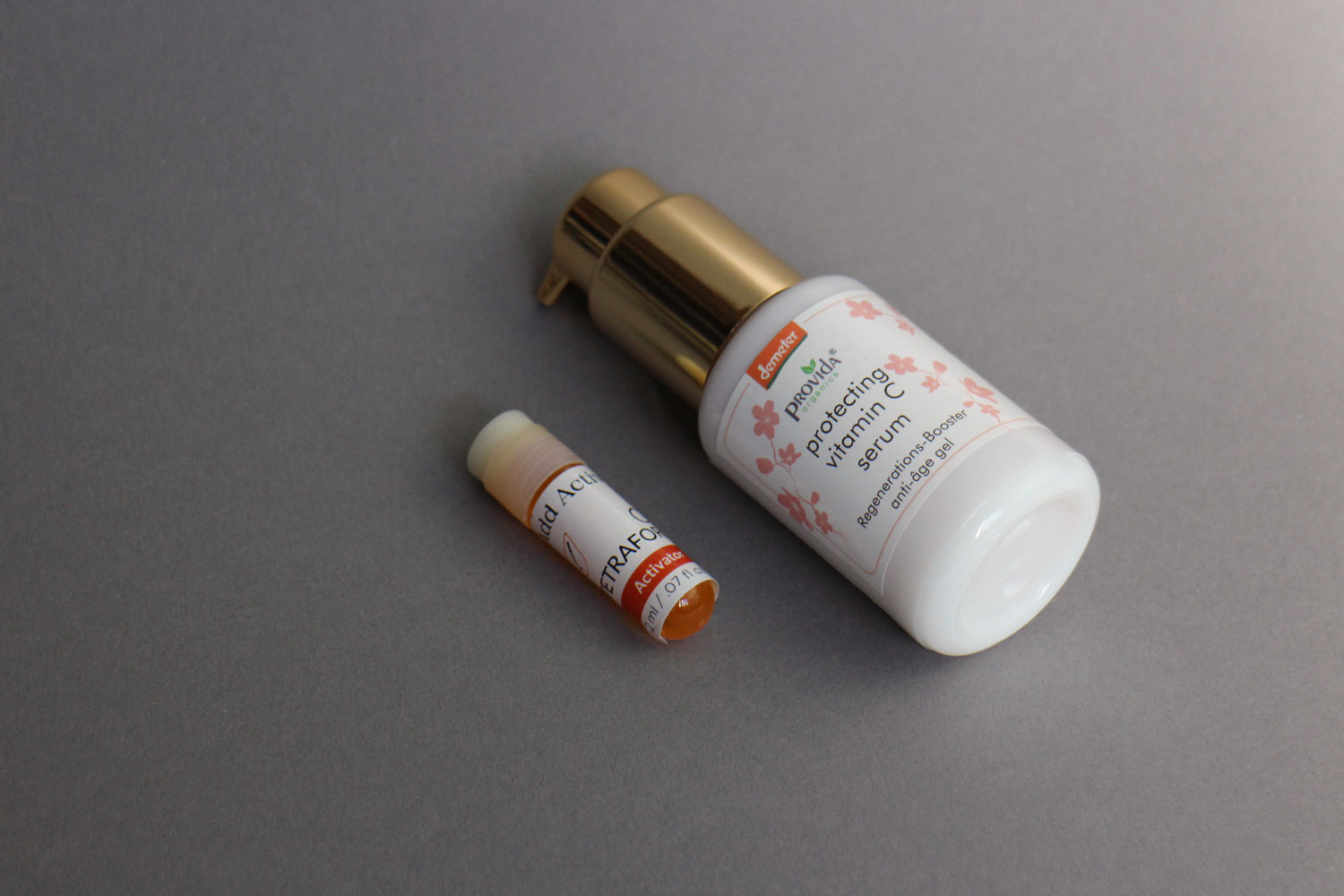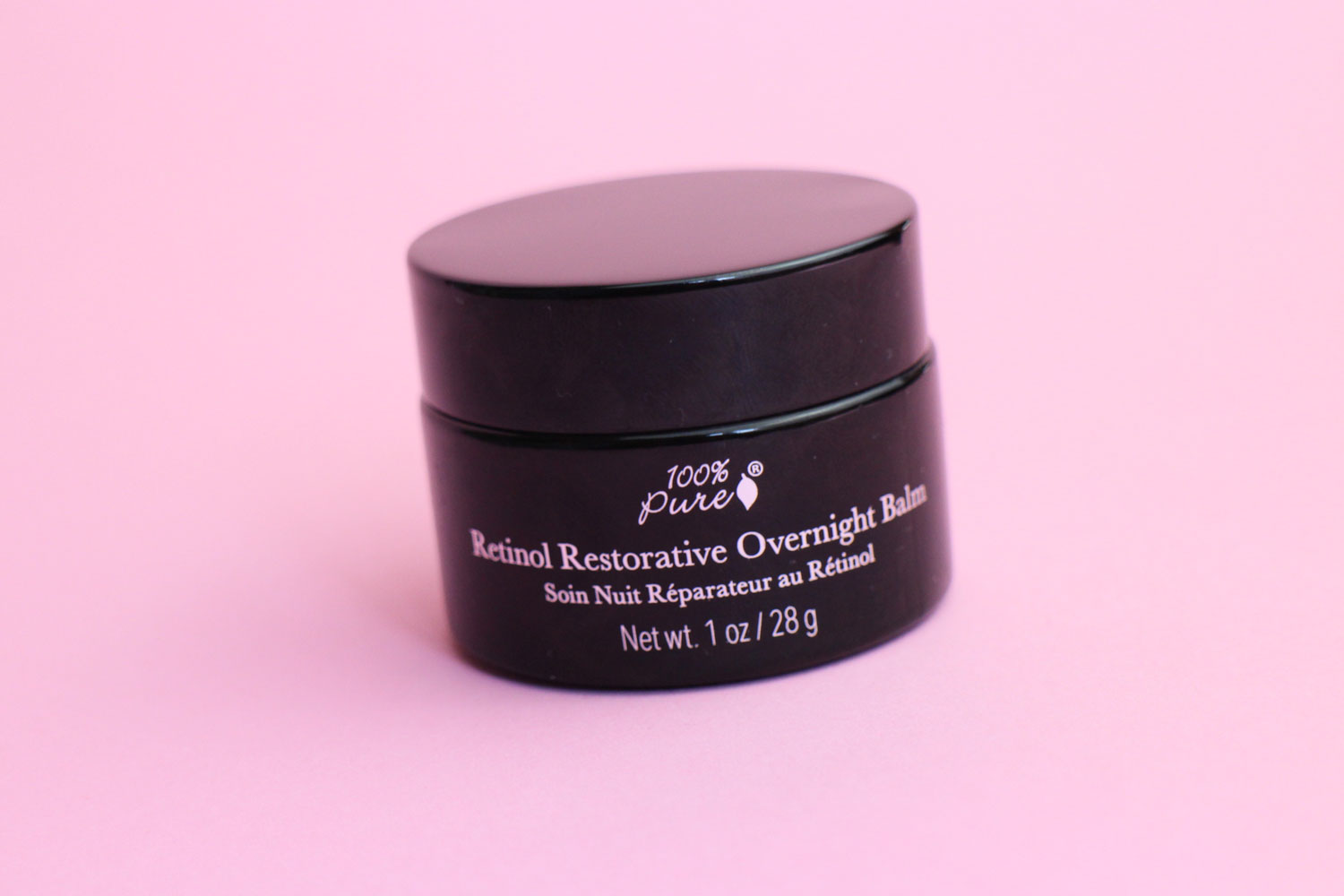This is a translation of my German blogpost about fruit acids (AHA, BHA and PHA), vitamin C and retinol in organic beauty. Enjoy!
In cooperation with Ecco Verde // If there’s one skin care trend that has grown in popularity in recent years (besides organic beauty, I mean 😉 ), it’s fruit acids and retinol. These ingredients are playing a major role on international skin care blogs right now. It is more of a renaissance than an entirely new development – after all, retinol first became popular in the 1990s – but over the last 25 years or so, product formulations have evolved quite considerably.
In the organic beauty sector, however, fruit acid and retinol products are still pretty underrepresented. I noticed this at Vivaness trade show in particular so I decided that the time has come to publish this guide to fruit acids in organic beauty! I’ll be giving you some background info on the different types of fruit acids, retinol and vitamin C and presenting selected organic beauty products that feature these ingredients.
My cooperation partner for this post is organic online store Ecco Verde. They have a very large selection of fruit acid/retinol/vitamin C products – in fact, I think they offer more of these brands than any other online or offline beauty retailer in Europe. For each category I will provide a list of products which are linked to the respective Ecco Verde shop entry.
AHA (and a little BHA)
What exactly is AHA? The term AHA (short for Alpha Hydroxy Acids) refers to fruit acids which naturally occur in fruits and plants. Examples of AHAs are glycolic acid, mandelic acid, citric acid or lactic acid. These acids help to remove dead skin cells by very gently sloughing off the surface of the skin’s corneal layer – the effect is a bit like a chemical peel you might get at a salon or cosmetic institute.
After a fruit acid peel the skin looks fresh and glowing and there’s an additional benefit: any active ingredients, creams or lotions that you apply after a fruit acid peel are much more thoroughly absorbed into the skin. Some fruit acids can even stimulate collagen production inside the skin, depending on the size of the molecules.
The molecular size of a fruit acid also affects its skin tolerability: lactic acid and mandelic acid, for example, are considered to be more gentle than glycolic acid. For combination skin, salicylic acid (which is a BHA, i.e. Beta Hydroxy Acid) is often recommended because salicylic acid penetrates the upper layers of the skin to help resolve keratinization (cornification) disorders. In order for the fruit acids to work the pH level of the product should be between 3 and 4. Anything higher than a pH level of 6 won’t really have a peeling effect on the skin.
How should I use AHA? Products formulated with fruit acids are generally pretty acidic and can cause redness and irritation, so you should be careful when you use them. Fruit acids can help refine a thick corneal layer (keratinization at the sebaceous glands can result in the development of acne) and therefore improve acne skin. Many women use fruit acids as an anti-ageing ingredient because certain acids can help cell regeneration.
Ideally you should apply acidic products as part of your night time routine. And because these products reduce the skin’s natural UV protection you must apply sun protection during the day. Every day! If you have sensitive skin or your skin is prone to rosacea or couperose, be very careful and only use gentle acids with larger molecules that do not penetrate the skin too deeply (like mandelic acid, lactic acid or products formulated with PHA – see paragraph below). I always recommend observing your skin closely to see how it reacts to the acids – if the concentration of acids is too high they can damage the skin’s protective barrier.
Organic beauty products with AHA and BHA:
- Mádara Brightening AHA Peel Mask (lactic acid)
- REN Ready Steady Glow Daily AHA Tonic (lactic acid and BHA: salicylic acid)
- Aubrey Organics Age Defying Therapy AHA Mask (fruit acids from citrus fruits)
- Fitocose AHA Anti-Wrinkle Fluid (10% glycolic acid, pH 3,5)
- Fitocose Anti-Wrinkle Cream (8% glycolic acid)
- Alkemilla Glycolica Fruchtsäure Vorbereitungspflege (glycolic acid 1-2% and fruit acids from mangos, lemons and passion fruits)
- Domus Oleo Sebo-Lift Regenerierende Nachtcreme (salicylic acid, lactic acid and glycolic acid as well as AHA derived from apples, lemon and red grapes)
- Alkemilla Glycolica Körpercreme 16% (glycolic acid 16%)
- Alkemilla Glycolika Gesichtsmaske 24% (glycolic acid 24%)
- Le Erbe di Janas: Elixier mit Fruchtsäuren (AHA from various fruits – this product is an additive (booster) for other skin care products)
- Domus Oleo Gesichtsstraffungs-Creme (AHA from fruits)
- Paul Penders Citrus Fruit Exfoliant (AHA and BHA from fruits and herbs)
- Pai Skincare Copaiba Deep Cleanse AHA Mask (AHA and BHA from fruits and herbs)
- Evolve Organic Miracle Mask (AHA and glycolic acid from blueberries, lemons, oranges and sugar maple)
- Fitocose Lightening Gel (glycolic acid 10% und koji acid 1%)
- Alkemilla Glycolica Gesichtscreme 3% (glycolic acid 3%)
- Fitocose Body Cream Glycolic Acid 12% (12% glycolic acid, pH 3,5)
- Acorelle Pflege gegen eingewachsene Haare (lactic acid)
- Antos Peelendes Serum (fruit-based AHA)
- Dr. Organic Tea Tree Treatment Gel (AHA from fruit extracts and BHA salicylic acid)
- Fitocose Anti Blemish Cream (BHA salicylic acid)
- Fitocose Mandelic Acid Facial Gel und Mandelic Acid Facial Cream (both are formulated with 10% mandelic acid)
Short review: Ready Steady Glow Daily AHA Toner from REN
Glow tonics are very trendy at the moment so I decided to try out the Ready Steady Glow Daily AHA Toner from REN – it’s one of the US brand’s bestsellers. REN belongs to the brand stable of Unilever, by the way. The tonic is formulated with lactic acid and a bit of BHA; both of these acids are considered to be gentle on skin so they are usually well-tolerated. I measured a pH value of 4 so the acids should be effective without irritating the skin. You apply the toner on cleansed skin as a daily treatment product. After several applications my impression was that the toner did make my skin look fresher and it also had a hydrating effect. I apply a facial oil on top of the toner. The Glow Toner has a very light scent of citrus fruits and florals.
Short review: Body Cream Glycolic Acid 12% from Fitocose
Italian beauty brand Fitocose offers a whole range of products formulated with glycolic acid. The Body Cream Glycolic Acid 12% from Fitocose contains 12% glycolic acid which is a pretty high concentration but still ok for the body. The pH value of 3,5% is also good. The body lotion is easy to apply and is absorbed quickly into the skin; the scent is perhaps a little artificial. My skin feels moisturised and very soft and after 1-2 weeks it also felt a little smoother than with a regular body lotion.
PHA
In my previous paragraph about AHA and BHA I already mentioned Poly Hydroxy Acids (also called PHA). PHAs are a recently developed type of fruit acid. They have larger molecules so skin tolerance is very high, even with skin types that are prone to rosacea or couperose. In addition, PHAs offer antioxidant protection. The best known PHAs are gluconolactones.
Organic beauty products with PHA:
- Bioearth Hand Mask Spots and Pigmentation (mandelic acid and gluconolactones)
- Bioearth Anti-Pigmentflecken Gesichtsmaske (sheet mask with mandelic acid and gluconolactones)
- Bioearth Anti-Pigmentflecken Serum (mandelic acid and gluconolactones)
- Kivvi Skin Renewals Facial Peeling Mask (glucono-delta-lactones)
Short review: Hand Mask Spots and Pigmentation from Bioearth
The Hand Mask Spots and Pigmentation from Italian brand Bioearth is a kind of thick gel: you apply it to the back of your hands and leave it on 10-15 minutes so the mandelic acid and gluconolactones (PHA) can do their work. These two ingredients are listed on 2nd and 3rd place of the INCI list and help to brighten skin pigmentation and lighten darker spots. The product’s pH value of 3,5 is also good. After the hand mask has started to dry a little you wash the gel off with water. The mask does not contain perfume; the scent is barely perceptible. My hands liked the gel and the skin was ultra smooth and soft afterwards. I almost felt like a hand model 🙂 .
Short review: Face Serum Spots and Pigmentation from Bioearth
The Face Serum Spots and Pigmentation from Bioearth also contains mandelic acid (AHA) und gluconolactones (PHA) but it is based on water, sand lily extract (helps against hyper-pigmentation) and moisturising hyaluronic acid. The two acids are present in a low concentration and the pH value is not acidic so the fruit acids help against inflammation rather than peel the skin. I like the gel-like smooth texture of the serum, it hydrated well and left my skin feeling plump. Scented with a light floral fragrance and notes of lily.
Vitamin C
Vitamin C is a true multi-tasker: it stimulates collagen production, helps against pigmentation disorders (vitamin C prevents melanin from forming) and offers antioxidant protection against free radicals. Unfortunately it isn’t easy to develop a product with pure vitamin C for use on the skin. Vitamin C becomes unstable very quickly so unless a vitamin C serum is packaged in an air-tight dispenser or jar, the ascorbic acid loses its power within a few weeks. You also need an acidic pH value (lower than 3,5) for the product base. Depending on the dosage a vitamin C product can also have a peeling effect on the skin.
These are some of the reasons why beauty manufacturers often use vitamin C derivatives rather than straight ascorbic acid. The derivatives turn into ascorbic acid once they are applied to the skin, but the effect is milder than it would be with pure ascorbic acid. Examples of such derivatives are magnesium ascorbyl phosphate, ascorbyl palmitate, sodium ascorbyl phosphate, ascorbyl glucoside or – very new – ascorbyl tetraisopalmitate. These vitamin C derivatives do not need an acidic product base and are therefore less irritating to the skin.
Organic beauty products with vitamin C:
- Add Actives C20 Tetraforce Activator (ascorbyl tetraisopalmitate in squalane and rosehip kernel oil – this product is not a peel)
- Fitocose Jalus Vitamin C Serum und Jalus Vitamin C Anti-Age Fluid (sodium ascorbyl phosphate and ascorbyl palmitate)
- 100% Pure Vitamin C Serum (2% magnesium ascorbyl phosphate)
- Provida Organics Mille Fleurs Protecting Vitamin C Serum (ascorbic acid, pH value 3,5 – measured by myself)
- Fitocose C10 Jalus Facial Serum (sodium ascorbyl phosphate)
- Nuori Supreme-C Treatment (ascorbic acid, ferulic acid, gluconolactone)
- Fitocose Jalus Spot Serum (sodium ascorbyl phosphate and ascorbyl palmitate, salicylic acid)
- REN Flash Rinse 1 Minute Facial (ascorbic acid)
- Kivvi Skin Renewals Pigmentation Spot Reducing Facial Serum (ascorbyl glucoside)
Short review: Mille Fleurs Protecting Vitamin C Serum from Provida
I was a bit surprised when I saw the Mille Fleurs Protecting Vitamin C Serum from German brand Provida – this vitamin C serum is actually certified by Demeter (one of the strictest organic seals in Europe). The serum is based on water, beetroot extract and rowanberry fruit extract; the vitamin C is ascorbic acid. The serum is not in air-tight packaging but the flacon is glass and the serum is drawn up with a pump dispenser. The pH value is 3,5 which keeps the vitamin C fresh. Still, I think should use up this serum as soon as possible in order to get the maximum effect. The vitamin C dosage is around 2% (based on my estimate from the ingredients listing). The serum feels moisturising on the skin and has a very light herbal scent.
Short review: C20 Tetraforce from Add Actives
The little bottle of C20 Tetraforce from Add Actives contains the vitamin C derivative ascorbyl tetraisopalmitate in a squalane solution – with a concentration of 20% it’s the ideal dosage for a modern and stable vitamin C derivative! In Asia this type of vitamin C is very popular since it is tolerated by many skin types (no acidic base necessary); it also has an antioxidant effect and helps to brighten pigmented skin patches. The orange colour of the C20 Tetraforce comes from the rosehip oil that is used in the formula. I applied the oil as a stand-alone product but also mixed it with other face oils and creams – it is absorbed very quickly into the skin without leaving any residue. As a face oil fan I really like this well-blended vitamin C concentrate. The small flacon (the serum is also availale in a larger size) is very convenient and lasted for a long time – what a great price-performance ratio.
Retinol
Retinol is usually considered to be the star amongst anti-ageing actives: this ingredient is very well researched and even in its lowest concentration retinol is said to help against wrinkles, increase the skin’s hydration levels, boost collagen production and even help with acne skin. However, retinol can also cause redness and skin irritation during the application. Retinol derivatives like retinyl palmitate and retinyl acetate have a gentler effect on the skin and are therefore more easily tolerated: retinyl palmitate and retinyl acetate only turn into the potent retinoic acid once they are applied to the skin. With retinol it can take several months until the anti-ageing effect is visible – and if you use a retinol product you absolutely must wear sunscreen every day.
So far I haven’t found any organic beauty products with (real) retinol: even when a product name contains the term “retinol” the manufacturer usually means plant-based carotenoids (like beta-carotene derived from carrots). The body eventually turns these carotenoids into antioxidant vitamin A which protects the cells – also a great skin care effect but different from what retinol does.
Organic beauty products with “retinol”:
- 100% Pure Multi-Vitamin + Antioxidants Potent PM Serum (10% magnesium ascorbyl phosphate, 10% niacinamide, 10% vitamin E, 0,5% retinol from carrots)
- 100% Pure Retinol PM Eye Cream (2,5% carrot-derived retinol)
- 100% Pure Retinol Restorative Neck Cream 2,5% carrot-derived retinol)
- 100% Pure Retinol Restorative Overnight Balm (2,5% carrot-derived retinol)
- La Saponaria No-Age Gesichtscreme Granatapfel (plant-based retinol)
Short review: Retinol Restorative Overnight Balm from 100% Pure
Although the Retinol Restorative Overnight Balm from US brand 100% Pure doesn’t contain any actual retinol it still offers a host of antioxidant ingredients, such as 2,5% plant carotenoids (the brand calls this “new retinol”), vitamin E and a vitamin C derivative. The water-free balm is based on avocado oil and sunflower oil; it has a very soft jasmine fragrance which I like (needless to say!). I apply a pinch of the soft balm on damp skin at night, the balm immediately turns into an oil and is then quickly absorbed into the skin. A soft film of beeswax locks the moisture from the antioxidants and plant oils into the skin. Most suitable for dry and mature skin types.
I hope you enjoyed this article. Have fun googling the products!
[Click here for the original German article: Fruchtsäuren (AHA, BHA und PHA), Vitamin C und Retinol in Naturkosmetik]





